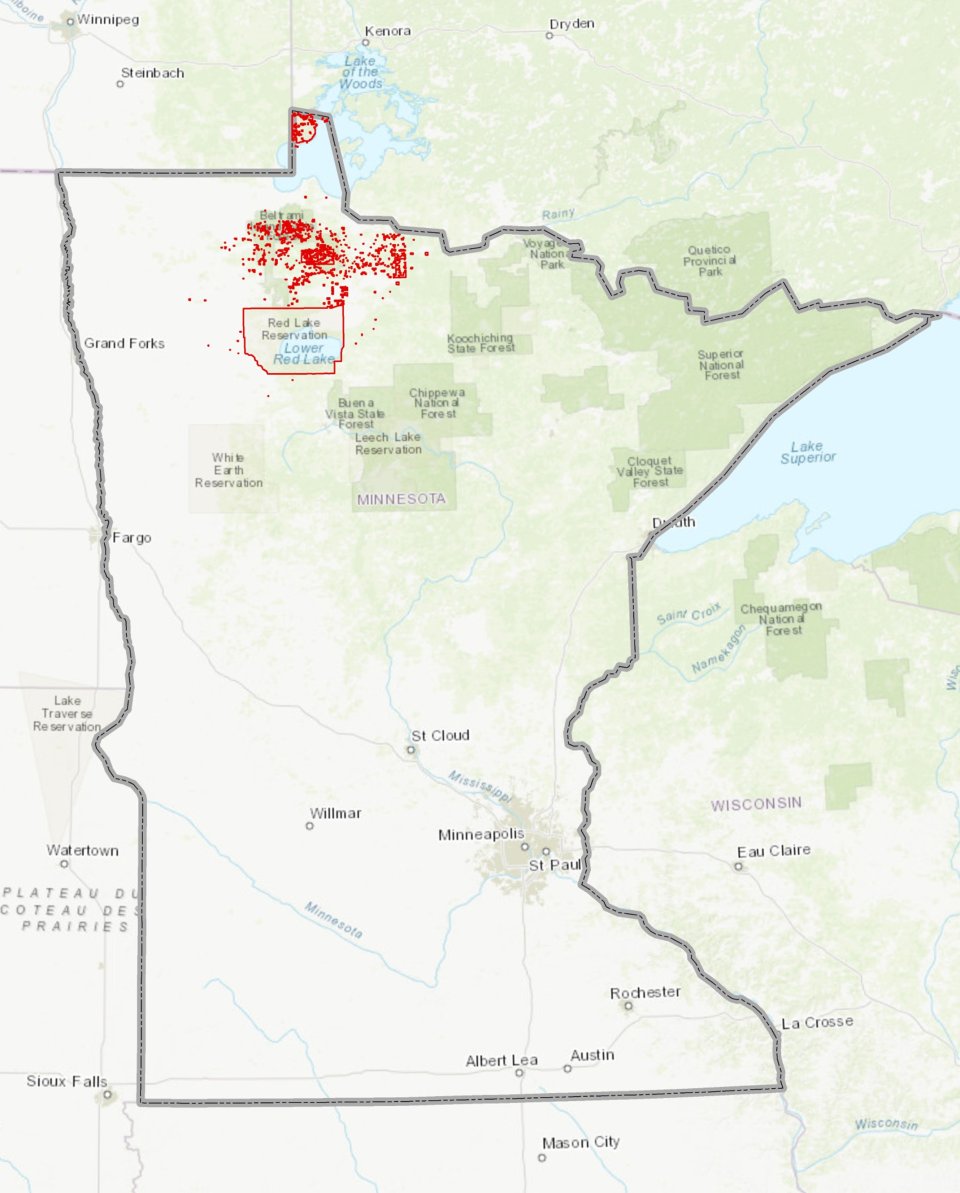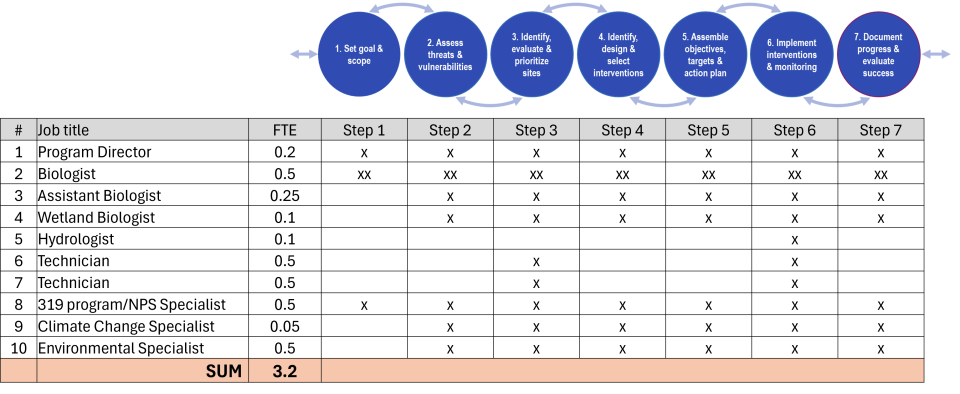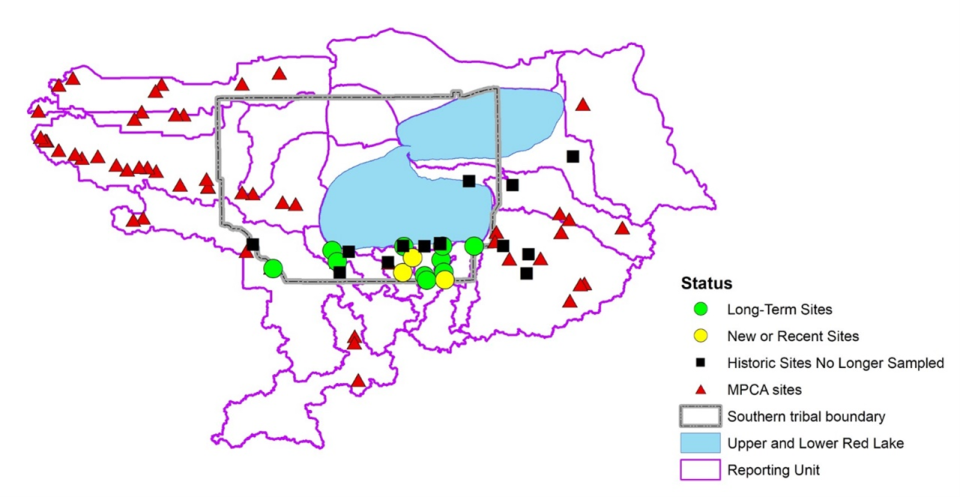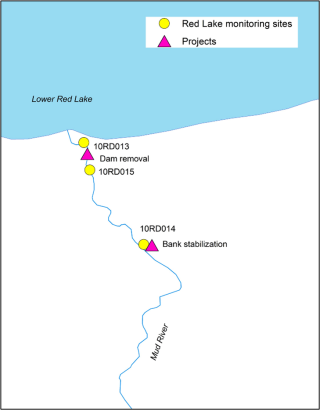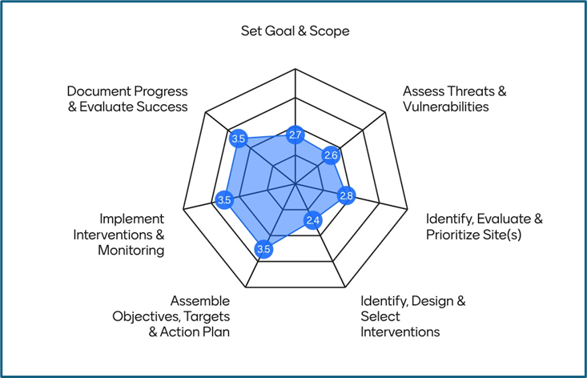Region 5 Red Lake Nation Stream Monitoring and Management
Quick Look 
Collaboration Goal:
Use the Organon with Tribal scientists of the Red Lake Nation to conduct a strategic evaluation of their stream monitoring and management program.
Process:
- Conduct an inventory of major monitoring and management program elements followed by a detailed synopsis of components using the seven steps of the Organon.
- Evaluate how steps in the Organon cycle, and connections between steps, could be implemented more efficiently and effectively.
- Develop adaptive management questions for each step to be revisited on a regular basis, to help the Red Lake Nation dynamically adjust to changing conditions and priorities.
Benefits to the Tribe:
- A holistic exploration of how program goals and achievements can be strengthened by improved flow of information between planning science and implementation science.
- A Strategic Evaluation Document with step-by-step analysis of organizational capacity and state of the science for achieving goals, and a framework for periodically revisiting areas for improvement based on evolving information and lessons learned over time.
- Downloadable Evaluation Starter Document that can be edited and adapted for use by other Tribes and for other waterbody types.
Background
The Red Lake Nation in Minnesota (Figure 1) has a "Treatment as a State" agreement with the U.S Environmental Protection Agency (EPA) and monitors and manages streams on the reservation to ensure compliance with the Clean Water Act (CWA). The focus is on protecting beneficial uses like drinking water, aquatic life, recreation, and cultural practices. Overall, the streams that flow through their lands are in good condition. Water quality impairments are primarily from low dissolved oxygen and elevated nutrient, sediment and bacteria levels. The main sources are nonpoint source pollution from residential development and agricultural areas located outside tribal lands, and some point sources such as feedlots and altered hydrology from ditching and road crossings. Changing environmental conditions and extreme events such as droughts and floods are also significant threats, although impacts to date remain unclear.
The Red Lake Nation established the Red Lake Department of Natural Resources (RLDNR) Water Resources Program in 1989 with responsibilities to address CWA concerns. For this partner project, Tribal scientists of the RLDNR worked collaboratively with the EPA to use the Organon (collaborative framework for resilience planning) to conduct a strategic evaluation of their stream monitoring and management program.
Methods
Project implementation started with a collaboration plan that included milestones, meeting dates and key participants and their roles. Baseline information was compiled through review of existing documentation and a series of conference calls and interviews with RLDNR staff. RLDNR staff then collaborated with EPA and contractor staff to produce a Strategic Evaluation Document that used the Organon elements as a structure for program assessment. The seven elements (steps) of the Organon cycle are: set goal & scope; assess threats & vulnerabilities; identify, evaluate and prioritize site(s); identify, design & select interventions; assemble objectives, targets & action plan; implement interventions & monitoring; and document progress & evaluate success.

For Red Lake’s Strategic Evaluation Document, inventories were developed for key components of the Red Lake stream program to document how well-covered each Organon element was in terms of: 1) different staff members’ work areas (i.e., staffing capacity); 2) funding sources; and 3) major reports produced. The inventories were followed by a deeper systematic assessment of the specific activities being routinely performed (e.g., Figure 2) for each of the seven Organon elements. This “step-by-step drill down” focused on activities and outcomes that were of greatest interest and relevance to the Red Lake Nation, with the intent of identifying opportunities for continued improvement and/or expansion over time, as appropriate. The cycle culminates in the implementation and monitoring of stream management interventions and eventual evaluation of their effectiveness. For evaluation of existing and future monitoring and restoration projects, a tracking spreadsheet was developed to document for each project:
- Outcome or desired change (how "success" is being defined).
- Biggest challenges to achieving the desired outcome.
- Overall outcome (worked, failed, mixed, unclear).
- Is the design holding up well? How much follow-up maintenance has it required?
- Does the same design and/or strategy seem viable for future activities? Are expected changes in environmental conditions being taken into account?
Finally, based on the information from the inventories and the step-by-step drill down, the team compiled a summary list of programmatic strengths and needs. This will be used moving forward to maintain strengths such as strong monitoring efforts and powerful external collaborative networks and improve on ever-expanding needs for data management and logistical resources.
Results
The Strategic Evaluation Document first presents the higher- level programmatic context in the form of inventories of current staffing and capacity. Inventory results on RLDNR staffing (Figure 3) show that there are currently 10 employees working on streams, including biologists, technicians, graduate students, and seasonal student interns. They actively monitor 14 stream sites for biology and water chemistry. All Organon steps are covered by appropriate staff, with especially strong representation in site evaluation (Step 3) and project monitoring (Step 6). That said, it is notable that because staff spend only a fraction of their time on streams, the management of the Red Lake Nation’s 371 stream miles is carried out by a Full-Time Equivalent (FTE) of 3.2 people.
The funding inventory showed that the Red Lake Nation's stream program is supported primarily by grants administered by EPA and the state of Minnesota, as well as resiliency grants from the Bureau of Indian Affairs (BIA). Combined, these funding sources cover all steps of the Organon well, but some steps are covered by only one source. This emphasizes the importance of ongoing work to add/diversify funding sources where possible to avoid resource lapses for certain steps if a unique source of funding for a step becomes unavailable.
The inventory of products that support the Red Lake Nation’s work cover a range of topics such as monitoring, quality assurance, water restoration and protection, non-point source management, etc. Collectively, these reports, strategies and plans inform all Organon steps, with some steps benefitting from information from multiple products. The challenge here is to ensure that key information from multiple resources is combined and synthesized as effectively as possible to serve a common step.
The next sections of the Strategic Evaluation Document present the step-by-step drill down. This starts with the overarching goal and scope (Step 1) for the Red Lake Nation’s stream program, which is to maintain the water quality of the steams, which are the arteries that feed Upper and lower Red Lake, and to protect beneficial uses like drinking water, aquatic life, recreation, and cultural practices. For each subsequent Organon step, the current resources that the program has for that step—including data, maps, monitoring strategies, reports, and other information—are compiled and summarized.
For example, under Step 2 (assess threats & vulnerabilities), RLDNR does regular monitoring of water quality stressors (e.g. dissolved oxygen, total phosphorus) and biological condition (e.g., index of biological integrity) at a variety of sites (Figure 4). Prioritization of sites (Step 3) for potential interventions (Step 4) is informed by the monitoring data as well as reports such as Minnesota’s Watershed Restoration and Protection Strategy. Due to limited capacity for costly projects, interventions such as culvert replacement (to improve connectivity and flow) and habitat restoration (to improve sturgeon spawning habitat) must be carefully considered. Selection is based not only on level of threats at sites, but also availability of funding, especially since changing environmental conditions increasingly require more expensive designs (such as oversized culverts to accommodate larger flows).
The step-by-step organization of information in this way reveals how well each element of the cycle is covered and where there are gaps. It also helps with looking at how information that is from different sources but common to a step is related and could be better integrated. And, when moving on to action planning, project implementation, and evaluation (Steps 5-7), ensuring effective interconnection of methods and information across steps comes into play. For example, The Red Lake Nation’s Mud River dam removal and bank stabilization projects (Figure 5) included planning (Step 5) to ensure that monitoring of threats (Step 2) at sites (Step 3) would continue post-implementation (Step 6) in order to inform effectiveness (Step 7) of the interventions based on their designs (Step 4).
Since information and conditions are constantly changing through time, it is essential to update steps and make adjustments when needed. For each step of the drill down, questions are posed for the Red Lake Nation to revisit on a regular basis to ensure incorporation of new/improved information as it becomes available and enable adaptation to changing conditions, priorities and goals. Examples include:
- What are the biggest threats affecting our ability to achieve the desired outcome (Step 2)?
- Are those threats being sufficiently considered in intervention designs (Step 4)?
- Which interventions have been most effective at achieving the desired results (Step 7)?
- Have any of the interventions reached a point where they are no longer viable and unlikely to reach the desired outcome, necessitating a readjustment of goals (Step 1)?
These types of questions emphasize the iterative nature of the Organon process in the context of programmatic work for stream monitoring and management. New information learned through time at any step could lead to improvements in other steps, the goal being to maximize efficiency and effectiveness at maintaining water quality and protecting beneficial uses for streams.
Outcomes
The Red Lake Nation partner project team found that developing the Strategic Evaluation Document revealed insights into how to improve coordinated flow of information between planning science (steps 2-4) and implementation science (steps 5-7) for continuous improvement of management outcomes. The process of developing the evaluation was as important as the Strategic Evaluation Document itself. This was because it prompted the Red Lake Nation to take a step back and take a holistic look at their program for a broader view of connections between program components and to identify areas to come back to for future improvements. Red Lake Nation intends to work toward addressing the opportunities identified during the evaluation to further strengthen use of monitoring data and other information for decision making and management activities. As a “living document” that is updated periodically, the Strategic Evaluation Document has the added benefit of helping new hires become more quickly oriented to the history and reasoning behind ongoing decisions and practices of the program.
After completion of the Strategic Evaluation Document, project results and products were shared with other Tribes located in EPA Region 5 through an interactive webinar given at the Tribal Environmental Program Management (TEPM) Conference in April 2025. There was broad representation of participants who worked in both planning science and implementation science, and on a variety of waterbody types (streams, lakes, wetlands, groundwater, wild rice). During the interactive presentation, a series of polls and open-ended questions were used to solicit feedback on the extent to which activities related to the seven Organon steps are conducted across other Tribal programs (Figure 6), and to gage the level of interest from other Tribes in future Organon collaborations. Participants brainstormed potential valuable uses of the Organon for their own work, such as: 1) creating a structured space for reviewing programs; 2) applying it across multiple programs (streams, lakes, wetlands, drinking water, etc.) as a whole; and 3) envisioning how to efficiently build capacity moving forward.
In response to expressions of interest from other Tribes and organizations who may wish to use this approach, the team developed an "Evaluation Starter Document" that anyone can use to create their own inventories and step-by-step drill downs using the Organon. It contains summary information and examples based on the Red Lake Nation effort but is fully editable so that users can keep what is helpful and change what is needed, according to their own situation. The Evaluation Starter Document can also be used as a template for other waterbodies or media (besides streams), as well as other programs (besides the Red Lake Nation's) that carry out monitoring and management for natural resources.
To request the fillable Evaluation Starter Document, please email the Red Lake Water Resources group at DNRWaters@redlakenation.org.
Partner Team
Red Lake Department of Natural Resources (RLDNR)
Kayla Bowe, Biologist
Shane Bowe, Water Resources Program Director
Environmental Protection Agency (EPA) Region 5
Danielle Grunzke, Tribal Coordinator
Kate Balasa, Adaptation Coordinator
EPA Office of Research and Development (ORD)
Jordan West, Senior Ecologist, EPA ORD
Technical Support
Jen Stamp, Tetra Tech Inc.
Anna Hamilton, Tetra Tech, Inc.

